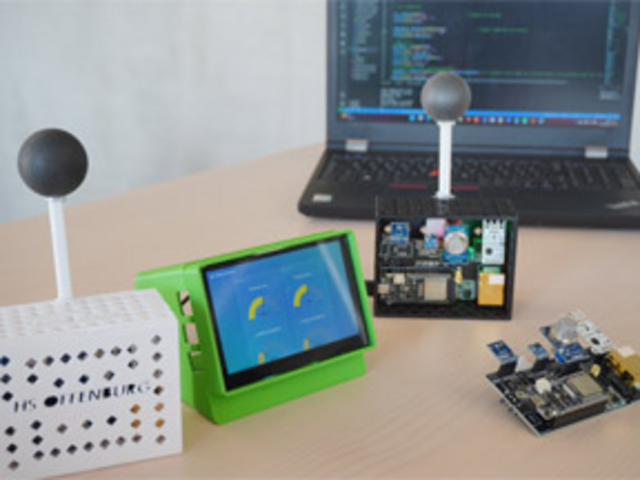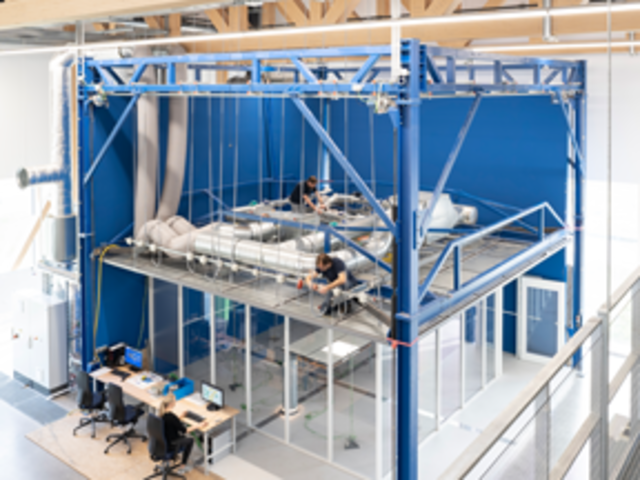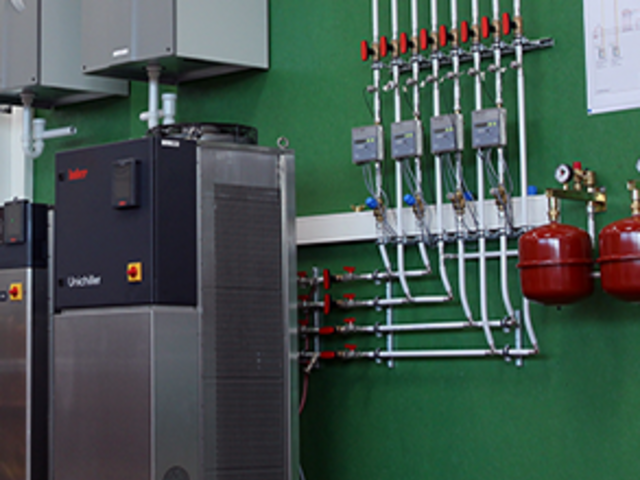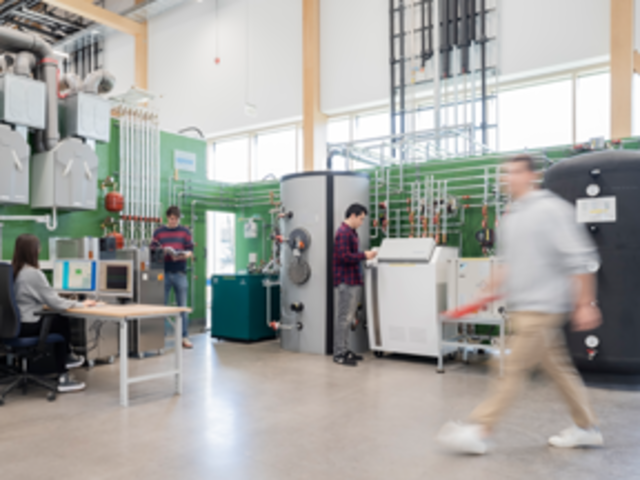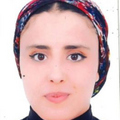Advanced Building Technology (Professors Pfafferott and Lämmle)
While our society is willing to go for zero energy and plus energy buildings, our buildings still have to be prepared for the use of 100% renewable energy.
As a result, innovations in building technology and grid-responsive operation of buildings are urgently required. A central challenge is the optimization of facility and controlling in the technical building equipment for decreasing energy demands. This includes especialy lower heat flow densities for heating and cooling.
The E2G group at Offenburg University conducts research in the field of technical building equipment with a focus on heating and cooling with thermo-active construction components, ventilation technology and indoor air flow, façade-integrated building technology, and energy system technology for buildings.
Economic viability, energy and resource efficiency as well as workspace and living quality are the focus of metrologically oriented studies.
Projekte
Building Information Modeling, or BIM, is used for the optimized planning and technical documentation of buildings through all construction and operational phases. Still, BIM methods are only slowly finding their way into the planning, implementation and operational phases of building technologies (German: Technische Gebäude Ausrüstung, or TGA).
In this project, we are developing BIM methods for the commissioning and operational optimization of TGA systems and demonstrating commissioning with IoT and BIM on a low-energy building, the Regional Innovation Center for Energy Technology at Hochschule Offenburg (RIZ Energie). BUiLD.DIGITiZED thus provides impetus for the broad application of BIM methods, from design planning to implementation to commissioning.
FKZ: 03EN1021A
The µGRiDS simulation model enables the operational analysis of small-scale building energy systems , decentralized energy network systems and their decentralized control based on price signals. The optimal operating strategies are derived based on a real system and include the engineering know-how about the individual components. Existing models can also be used to develop and implement energy systems of different sizes, for example comprising several combined heat and power plants or heat pumps. In addition to the price signal, the heat and cooling load will also be taken into account in the optimizer.
www.energiesystem-forschung.de/forschen/projekte/meo
FKZ 03ET4078H
The energy-system transition facilitates more renewable energies and decentralization. The resulting increase in diversity, comprehensive participation and complexity of (interconnected) energy generation require extensive transformation of the infrastructure for energy distribution and storage. To guarantee a both secure and inexpensive supply, solutions on the prosumer level with sector coupling are being discussed. Through intelligent grid connection and control of these systems, the flexibility gained can be used to support the grid.
We are developing supervisory, grid-supportive control algorithms and operation management strategies for sector-coupled, hybrid energy systems, providing heating/cooling and electricity with different – primarily renewable – final energies. The energy prosumers are designed for neighborhoods and districts with a nominal electrical output of approx. 1 MW, to provide heating/cooling and electricity as efficiently as possible with a very high proportion of renewable energy sources. The coordinated system optimization of the prosumers is demonstrated with a supervisory operation management strategy for five trans-regionally distributed energy islands.
aca-modes.insa-strasbourg.fr/de/startseite/
The project is funded by INTERREG V Oberrhein 3.15 and Wissenschaftsoffensive 2018.
University and vocational students work together on transforming a shipping container into an information point illustrating elements of building technology and their respective functions.
www.ise.fraunhofer.de/de/forschungsprojekte/shk4futureenergysystems.html
Funded by the German Ministry for Economic Affairs and Energy in cooperation with the Fraunhofer ISE, Freiburg Chamber of Commerce, and Richard Fehrenbach Vocational School in Freiburg.
If a comfortable atmosphere in an office space is also achieved in an energy-efficient manner, it has a positive effect on both the working and the global climate. However, the handling of corresponding building technologies has to be learned. The interdisciplinary KLONG project set the task of providing users with the necessary specialist knowledge by producing smart educational films.
klong.hs-offenburg.de
Funded by badenova AG & Co. KG (Innovationsfonds Klima- und Wasserschutz 2017) in cooperation with the City of Offenburg.
In the joint project MOSAIK, an innovative urban climate model is developed which should be able to simulate the urban microclimate in large cities like Berlin with a spatial resolution of less than 10 meters and be a user-friendly tool for urban planning. Hochschule Offenburg’s part is developing the building model, which calculates the indoor climate and the energy demand of the individual building zones depending on their specific parameterization. This primarily concerns the building physics of the facade, the use of the space/building, user behavior, control strategy/operation management, and the technical equipment. The agreed driving variables are the facade and boundary layer temperatures as well as the local irradiation and wind speed (if necessary with wind direction) from the urban climate model. To minimize the computation time and allow for less complex coupling between space and urban climate via the facade temperature, the building model is based on an analytical solution of the Fourier heat conduction equation and the energy balance of the space.
palm.muk.uni-hannover.de/trac
BMBF 01LP1601C
The provision of cooling from waste heat is a very energy-efficient option. A large potential for adsorption chillers lies in the capacity class below 10 kW cooling. Here, industrial waste heat or micro-cogeneration plants can be considered as a source of power. In a laboratory setup at INES and a model-based, theoretical investigation, a trigeneration system with a hot and a cold storage tank combined with a conventional reversible heat pump is evaluated in terms of energy efficiency and grid-supportive operation.
Internal financing, cooperation project, DENE doctoral research group.
Many decentralized regions in the world suffer not only from a shortage of clean drinking water, but also from a lack of infrastructure and thus a shortage of energy sources. About two billion people globally have neither electricity nor access to clean drinking water. Using solar energy to operate water treatment plants and desalination systems could provide a major solution to the problem. What is needed is an energy-autonomous, robust and, if possible, maintenance-free process that ideally covers the entire production chain from raw water extraction and purification to disinfection and distribution. SolarSpring GmbH (SSP) systems used for this purpose are essentially solar thermal driven membrane distillation (seawater desalination), ultrafiltration (freshwater treatment) and UV disinfection (sterilization), with the electricity required for operation being provided by photovoltaics. Typical system sizes vary from 150 L to 20 m³ of drinking water per day, although larger overall systems can also be produced thanks to a modular design.
FKZ 03FH009PX4
Measurement evaluation of facade-integrated parapet units (incl. air conditioning) and decentralized ventilation units in comparison to window ventilation and centralized ventilation units with special consideration of indoor air flow and energy efficiency.
Industrial project with several project partners, cooperation project with Fraunhofer ISE.
Further development of predictive methods aiming at adapting to different room characteristics. By using modern methods (e.g., neural networks, artificial intelligence, model-based control), algorithms with the ability to learn can adapt to differently used zones in the building independently. Such methods can also react automatically to changes in room characteristics caused by fluctuations in use.
www.baufachinformation.de/Bauteilaktivierung/buecher/242406
www.ines.hs-offenburg.de/fileadmin/Einrichtungen/ines/images/1_Institut/03_Forschungsgruppen/BAUTEILAKTIVIERUNG_sd-bp2017_Pfafferott.pdf
BMBF 03FH022I2
In the two subprojects, “Basic Principles of Building Physics and Energy Economics” and “Building Model for Integration into The Forecast Models of the German Weather Service”, the needs for action in the area of "Urban Climate / Microclimate / Indoor Climate” are identified from an energy-economic perspective. On the basis of a simulation model it has been possible to quantify, at least approximately, the interaction between buildings and urban climate.
This project also includes support (Advisory Board) for the “Sonderforschungsbereich 1736: Urban Climate and Heat Stress (UCaHS)”of the DFG, the WHO working group “Health and Climate Change,” and the “Weiterentwicklung der Testreferenzjahres-Datensätze”.
Cooperation project with the German Weather Service (DWD)
Measurement and model-based analysis of building operation with the components earth probe, earth/air coil, ventilation system with regenerative heat recovery, absorption heat pump and different surface temperature control systems (with temperature cascading).
https://www.energiewendebauen.de/projekt/sporthalle-in-passivbauweise-mit-ausgekluegeltem-energiekonzept/
BMWi 0327431S
Development of an exergetic monitoring system for buildings using geothermal energy. The project focuses on the metrological analysis of buildings with geothermal energy use and thus contributes to the system integration of so-called LowEx components in the buildings and the geo-coupled systems.
http://lowexmonitor.ise.fraunhofer.de/
Cooperation project with Fraunhofer ISE, esp. DataSTORAGE energy database.
Labore
Publications
J. Pfafferott, D. Kalz, R. Koenigsdorff. Bauteilaktivierung. Fraunhofer IRB Verlag 2015.
ISBN (Print) 978 3 8167 9357 1 und ISBN (E-Book) 978 3 8167 9358 8
D. Kalz, J. Pfafferott. Erfahrungen aus dem Gebäudemonitoring. In: Nutzerzufriedenheit in Bürogebäuden - Empfehlungen für Planung und Betrieb. A. Wagner, G. Höfker, T. Lützkendorf, C. Moosmann, K. Schakib-Ekbatan, M. Schweiker. Hrsg.: FIZ Karlsruhe; BINE Informationsdienst, Bonn. Fraunhofer IRB Verlag 2015.
ISBN 978-3-8167-9305-2
J. Pfafferott, D. Kalz. Thermal Comfort and Energy-Efficient cooling of non-residential buildings. Springer, 2014.
ISBN 3319045814 und ISBN 3319045822 (online)
J. Pfafferott. Reduce indoor heat exposure. in: Heat-health action plans, Hrsg. World Health Organization, Regional Office for Europe, 2010
K. Voss, P. Engelmann, J. Pfafferott, A. Wagner. Erfahrungen und Ergebnisse aus Demonstrationsprojekten des Nichtwohnungsbaus. in: Bauphysik-Kalender 2010. Energetische Sanierung von Gebäuden, Hrsg. N. A. Fouad, Ernst&Sohn, 2010
K. Voss, J. Pfafferott. Energieeinsparung contra Behaglichkeit? in: Umwelbewusstes Bauen, Hrsg. A. Maas, Fraunhofer IRB Verlag, 2009
J. Pfafferott. Ground cooling. in: Advances in passive cooling, Hrsg. M.Santamouris, Earthscan, 2007
J. Pfafferott, D. Kalz. Thermoaktive Bauteilsysteme in Nichtwohngebäuden. BINE themeninfo I/07
K. Voss, J. Pfafferott. Energieeinsparung contra Behaglichkeit? Reihe Forschungen, Bundesamt für Bauwesen und Raumordnung, Bonn, 2006
J. Pfafferott Erdwärmetauscher und Nachtlüftung. in: Bürogebäude mit Zukunft, Hrsg. K. Voss, S. Herkel, G. Löhnert, A. Wagner, M. Wambsganß, TÜV-Verlag, Köln, 2005
J. Pfafferott Enhancing the Design and Operation of Passive Cooling Concepts. Fraunhofer IRB Verlag, 2004
J. Pfafferott. Passive Kühlung mit Nachtlüftung. in: Facility Management, dwd Verlag, 2004
J. Pfafferott. Passive Kühlung mit Nachtlüftung. BINE themeninfo I/03
Pfafferott, J.; Rißmann, S.; Halbig, G.; Schröder, F.; Saad, S. Towards a Generic Residential Building Model for Heat-Health Warning Systems. Int. J. Environ. Res. Public Health 2021, 18, 13050.
https://doi.org/10.3390/ijerph182413050
Sawant, P.; Villegas Mier, O.; Schmidt, M.; Pfafferott, J. Demonstration of Optimal Scheduling for a Building Heat Pump System Using Economic-MPC. Energies 2021, 14, 7953.
https://doi.org/10.3390/en14237953
P. Sawant, A. Bürger, C. Felsmann, J. Pfafferott. Experimental demonstration of grid-supportive scheduling of a polygeneration system using economic-MPC. Energy and Buildings 254 (2022). https://doi.org/10.1016/j.enbuild.2021.111619
P. Sawant, C. Braasch, M. Koch, A. Bürger, S. Kallio. An energy-economic analysis of real-world hybrid building energy systems. CISBAT 2021. Journal of Physics: Conference Series 2042 (2021). https://doi.org/10.1088/1742-6596/2042/1/012095
J. Pfafferott, S. Rißmann, M. Sühring, F. Kanani-Sühring, B. Maronga. Building indoor model in PALM-4U: indoor climate, energy demand, and the interaction between buildings and the urban microclimate. Geosci. Model Dev., 14, 3511–3519, 2021.
https://doi.org/10.5194/gmd-14-3511-2021
J. Pfafferott, S. Rißmann, S. Kühnert U. Wittstadt. Adsorptionskältemaschinen – Betrieb mit Abwärmenutzung und netzdienlicher Betrieb in Kraft-Wärme-Kälte-Kopplung. HLH 71 (2020) NR. 07-08
S. Auerswald, C. Hörberg, T. Pflug, J. Pfafferott, C. Bongs, H.-M. Henning. Experimental Investigation of the Air Exchange Effectiveness of Push‐Pull Ventilation Devices. Energies 2020, 13, 5817
https://doi.org/10.3390/en13215817
B. Maronga, S. Banzhaf, C. Burmeister, T. Esch, R. Forkel, D. Fröhlich, V. Fuka, K. F. Gehrke, J. Geletic, S. Giersch, T. Gronemeier, G. Groß, W. Heldens, A. Hellsten, F. Hoffmann, A. Inagaki, E. Kadasch, F. Kanani-Sühring, K. Ketelsen, B. A. Khan, C. Knigge, Helge Knoop, P. Krc, M. Kurppa, H. Maamari, A. Matzarakis, M. Mauder, M. Pallasch, D. Pavlik, J. Pfafferott, J. Resler, S. Rissmann, E. Russo, M. Salim, M. Schrempf, J. Schwenkel, G. Seckmeyer, S. Schubert, M. Sühring, R. von Tils, L. Vollmer, S. Ward, B. Witha, H. Wurps, J. Zeidler, S. Raasch. Overview of the PALM model system 6.0. Geosci. Model Dev., 13, 1335–1372 (2020)
https://doi.org/10.5194/gmd-13-1335-2020
P. Sawant, A. Bürger, M. Doan, C. Felsmann, J. Pfafferott. Development and Experimental Evaluation of Grey-Box Models of a Microscale Polygeneration System for Application in Optimal Control. Energy and Buildings 215 (2020).
https://doi.org/10.1016/j.enbuild.2019.109725
P. Sawant, E. Ho, J. Pfafferott, Application and analysis of a model based controller for cooling towers in compression chiller plants, Heliyon. 6 (2020) e03249.
doi.org/10.1016/j.heliyon.2020.e03249
J. Pfafferott, S. Rißmann. Messtechnische Evaluation von thermisch und elektrisch angetriebener Kälteerzeugung. G|I 140 (2019).
ISSN 2195-643X
B. Maronga, G. Groß, S. Raasch, S. Banzhaf, B. Büter, A. Matzarakis, M. Mauder, J. Pfafferott, S. Schubert, G. Seckmeyer, H. Sieker, K. Trusilova, J. Zeidler. Development of a new urban climate model based on the model PALM - Project overview, planned work, and first achievements. Meteorologische Zeitschrift 78 (2019).
doi.org/10.1127/metz/2019/0909
R. Schwantes, L. Bauer, K. Chavana, D. Dücker, C. Felsmann, J. Pfafferott. Air gap membrane distillation for hypersaline brine concentration: Operational analysis of a full-scale module–New strategies for wetting mitigation. Desalination 444 (2018) .
doi.org/10.1016/j.desal.2018.06.012
R. Schwantes, K. Chavan, D. Winter, C. Felsmann, J. Pfafferott. Techno-economic comparison of membrane distillation and MVC in a zero liquid discharge application. Desalination 428 (2018).
doi.org/10.1016/j.desal.2017.11.026
J. Pfafferott, G. Henze, T. Lang. Anlagenaufwandszahlen für die Bauteilaktivierung in Abhängigkeit des Regelkonzeptes - Welche Betriebsführungsstrategie passt zu welchem Gebäude? Bauphysik 39 (2017).
doi.org/10.1002/bapi.201710032
J. Pfafferott, M. Frietsch, S. Himmelsbach, T. Lang. Messtechnische Bestimmung von Aufwandszahlen unterschiedlicher Flächentemperiersysteme. Bauphysik 38 (2016).
doi.org/10.1002/bapi.201610039
R. Albatici, F. Passerini, J. Pfafferott. Energy Performance of Verandas in the Building Retrofit Process. Energies 9 (2016).
doi.org/10.3390/en9050365
M. Rosenfelder, C. Koppe, J. Pfafferott, A. Matzarakis. Effects of ventilation behavior on indoor heat load based on test reference years. Int J Biometeorol 60 (2016).
doi.org/10.1007/s00484-015-1024-8
J. Pfafferott, M. Frietsch, T. Lang, M. Schmelas. Kalorische Messungen an thermisch aktivierten Bauteilsystemen. Messtechnik im Bauwesen, Bauphysik 37 (2015).
Coydon F., S. Herkel, T. Kuber, J. Pfafferott ,S. Himmelsbach. Energy performance of facade integrated decentralised ventilation systems. Energy and Buildings 107 (2015).
dx.doi.org/10.1016/j.enbuild.2015.08.015
Sawant P., N. Meftah, J. Pfafferott. Multiperspective Analysis of Microscale Trigeneration
Systems and Their Role in the Crowd Energy Concept. Journal of Electronic Science and Technology 13 (2015)
ISSN: 1674-862X
D. Kalz, J. Pfafferott, S. Herkel, M. Sonntag. Energieeffiziente Kühlung und Thermischer Raumkomfort: Erfahrungen aus dem Langzeitmonitoring von 42 Bürogebäuden. Bauphysik 36 (2014).
doi.org/10.1002/bapi.201410030
G. Salvalai, J. Pfafferott, M. Sesana. Assessing energy and thermal comfort of different low-energy cooling concepts for non-residential buildings. Energy Conversion and Management 76 (2013).
dx.doi.org/10.1016/j.enconman.2013.07.064
D. Kalz, F. Hölzenbein, J. Pfafferott, G. Vogt. Nutzerzufriedenheit mit dem thermischen Komfort in Bürogebäuden mit Umweltenergiekonzepten. Bauphysik 35 (2013).
doi.org/10.1002/bapi.201310082
S. Gopisetty, J. Pfafferott. Optimization of operational strategies for a low exergy office building. Energy and Buildings 60 (2013).
dx.doi.org/10.1016/j.enbuild.2013.01.023
J. Pfafferott, S. Herkel, F. Kagerer, D. Kalz, M. Sonntag. Kurzzeitmessungen zum thermischen Komfort im Sommer. Bauphysik 35 (2013)
J. Pfafferott, D. Kalz. Energieeffiziente Kühlung und thermischer Raumkomfort: Simulationsbasierte Evaluierung von Kühlkonzepten in verschiedenen europäischen Klimazonen (Teil 2). Bauphysik 35 (2013), submitted
D. Kalz, J. Pfafferott. Energieeffiziente Kühlung und thermischer Raumkomfort: Vergleichende Analyse von acht europäischen Nichtwohngebäuden (Teil 1). Bauphysik 34 (2012)
D. Kalz, J. Pfafferott, R. Koenigsdorff. Betriebserfahrungen mit Thermoaktiven Bauteilsystemen. Bauphysik 34 (2012)
D. E. Kalz, J. Pfafferott, S. Herkel, A. Wagner. Energy and efficiency analysis of environmental heat sources and sinks: In-use performance. Renewable Energy 36 (2011)
F. Nüßle, J. Pfafferott. Kühldeckensystem mit Aktivierung der Speichermasse der Betondecke. Bauphysik 33 (2011)
J. Pfafferott, M. Fischer, T. Strohmeyer, D. Wirth. Ein einfaches Modell zur Vorhersage der Fassaden- und Grenzschichttemperatur. Bauphysik 33 (2011)
C. Inard, J. Pfafferott, C. Ghiaus. Free-running temperature and potential for free cooling by ventilation: A case study. Energy and Buildings 43 (2011)
D. E. Kalz, J. Pfafferott, S. Herkel. Building signatures: A holistic approach to the evaluation of heating and cooling concepts. Building and Environment 45 (2010)
D. E. Kalz, J. Pfafferott, S. Herkel, A. Wagner. Building signatures correlating thermal comfort and low-energy cooling: In-use performance. Building research and information 37 (2009)
J. Pfafferott, P. Becker. Erweiterung des Hitzewarnsystems um die Vorhersage der Wärmebelastung in Innenräumen. Bauphysik 30 (2008)
S. Herkel, U. Knapp, J. Pfafferott. Towards a model of user behaviour regarding the manual control of windows in office buildings. Building and Environment 43 (2008)
J. Pfafferott, D. Kalz, P. Schossig, S. Herkel. Thermoaktive Bauteilsysteme mit integrierten Phasenwechselmaterialien - eine Simulationsstudie. Bauphysik 29 (2007)
G. P. Henze, J. Pfafferott, S. Herkel, C. Felsmann. Impact of adaptive comfort criteria and heat waves on optimal building thermal mass control. Energy and Buildings 39 (2007)
J. Pfafferott, S. Herkel, D. Kalz, A. Zeuschner. Comparison of Low-Energy Office Buildings in Summer using Different Thermal Comfort Criteria. Energy and Buildings 39 (2007)
K. Voss, S. Herkel, J. Pfafferott, G. Löhnert, A. Wagner. Energy efficient office buildings with passive cooling. Solar Energy 81 (2007)
J. Pfafferott, S. Herkel. Statistical Simulation of User Behaviour in Low-Energy Office Buildings. Solar Energy 81 (2007)
J. Pfafferott, S. Herkel., J. Wapler. Thermal Building Behaviour in Summer – Long-Term Data Evaluation using Simplified Methods. Energy and Buildings 37 (2005)
J. Pfafferott, S. Herkel, M. Wambsganß. Design, Monitoring and Evaluation of a Low Energy Office Building with Passive Cooling by Night Ventilation. Energy and Buildings 36 (2004)
J. Pfafferott. S. Herkel, M. Jäschke. Design of passive cooling by night ventilation – evaluation of a parametric model and building simulation with measurements. Energy and Buildings 35 (2003)
J. Pfafferott. Evaluation of three earth-to-air heat exchangers with a standardised method to calculate energy efficiency criteria. Energy and Buildings 35 (2003)
J. Pfafferott, A. Gerber, S. Herkel: Erdwärmetauscher zur Luftkonditionierung. Gesundheitsingenieur gi 199 (1998)
M.Hinze, R. Köcher, J. Pfafferott: Zur numerischen Simulation von Wärmenetzen. Forschung im Ingenieurwesen 12/96 (1996)
P. Sawant, J. Pfafferott, C. Felsmann. Quasi-First Principle Based Grey-Box Modelling of Microscale Trigeneration Systems for Application in Automatic Control. 10th IFAC Symposium on Control of Power and Energy Systems, Tokyo, 2018
F. Kanani-Sühring, B. Maronga, G. Groß, S. Banzhaf, B. Büter, A. Matzarakis, M. Mauder, J. Pfafferott, S. Raasch, C. Schneider, S. Schubert, G. Seckmeyer, H. Sieker, K. Trusilova, J. Zeidler. Project MOSAIK: Model-based city planning and application in climate change – development of the new urban climate model PALM-4U. 8th Japanese-German Meeting on Urban Climatology "Climate Analysis for Urban Planning", Osaka (Japan), 2017.
P. Sawant, J. Pfafferott. Experimental investigation of real-life microscale trigeneration system using adsorption cooling, reversible heat pump and a cogeneration unit. 7th IC-EPSMSO International Conference on Experiments/Process/System Modeling/Simulation/Optimization, 5th-8th July 2017, Athens (Greece)
Sawant P., J. Pfafferott. Experimental Analysis of Microscale Trigeneration Systems to Achieve Thermal Comfort in Smart Buildings. AIVC Conference 2015, 23th-24th September 2015, Madrid (Spain).
J. Pfafferott, A. Boerstra. Comfort, user behavior and energy efficiency - Summary of a workshop at Windsor Conference 2014. The REHVA European HVAC Journal, 51, 25-27 (2014).
F. Codyon, J. Pfafferott. Air renewal effectiveness of decentralized ventilation devices with heat recovery. 35th AIVC Conference, Poznan, 2014.
J. Pfafferott, A. Boerstra, F. Stevenson, G. Brager: Interactive Workshop on Comfort, User Behavior and Energy Efficiency. Windsor Conference 2014.
J. Pfafferott: Zur Wechselwirkung zwischen Gebäude und Stadtklima. Essener Klimagespräche 2014.
J. Pfafferott: Thermodynamics in a Nutshell: How to Optimize Energy Conversion Facilities. IES Workshop, Freiburg, 2014.
J. Pfafferott: Thermischer Komfort in Gebäuden mit Umweltenergiekonzepten. Uponor Kongress 2014, St. Christoph am Arlberg, 2014.
D. Kalz, J. Pfafferott, F. Hölzenbein, G. Vogt. Thermischer Raumkomfort in Nichtwohngebäuden - Nutzerzufriedenheit mit dem thermischen Komfort in Bürogebäuden mit Umweltenergiekonzepten. HLH Bd. 65 (2014).
A. Tudor, J. Pfafferott, N. Maier. Optimizing the operation of earth-to-air heat exchangers in high-performance ventilation systems for low-energy buildings - a case study. 34th AIVC Conference, Athen, 2013
J. Pfafferott, F. Kagerer. Erfolgsfaktoren in der energetischen Gebäudesanierung - Optimale Abstimmung zwischen Bauphysik und innovativer Anlagentechnik. HEIZUNGSJOURNAL 7/8 2012
J. Pfafferott, F. Kagerer. Erfolgsfaktoren in der Energetischen Gebäudesanierung - Energetische Sanierung 3.0. Uponor Kongress 2012, St. Christoph am Arlberg (AU), 2012
D. Kalz, R, Konigsdorff, J. Pfafferott. Thermoaktive Bauteilsysteme (TABS): Betriebserfahrungen aus der Praxis. DETAIL 11, 2011
J. Pfafferott, M. Fischer, D. E. Kalz. Low-energy buildings with night ventilation and earth-to-air heat exchangers – case studies and analysis. 32nd AIVC Conference, Brüssel (BE), 2011
J. Pfafferott, C. Koppe, C. Reetz. Extension oft he heat health warning system by indoor heat prediction. Conf. Climate and Constructions, Karlsruhe, 2011
F. Nüßle, J. Pfafferott. Kühldeckensystem mit thermischer Aktivierung der Betondecke. HLH 62 (2011)
J. Pfafferott , D. Jacob, D. Kalz, G. Salvalai. Evaluation of a low-energy cooling concept using a coupled building and plant simulation model, PALENC Conference 2010, Rhodos (GR)
D. E. Kalz, J. Pfafferott, S. Herkel. Cooling Concepts for Low-Energy Buildings using Environmental Energy: Thermal Comfort and Energy Efficiency. CLIMA 2010, Antalya (TR)
D. Kalz, J. Pfafferott, S. Herkel. EnBau – Bauphysik, thermischer Komfort und Energieeffizienz unter exergetischen Gesichtspunkten. LowEx Symposium 2010, Kassel
G. Salvalai, J. Pfafferott, D. Jacob. Validation of a low-energy whole building simulation model. SimBuild 2010, New York (USA)
J. Pfafferott, P. Mösle, G. Pültz, M. Lenzer. (Wie) Lässt sich thermischer Komfort normieren? HLH 61 (2010)
J. Pfafferott. Gebäude sanieren – Büro- und Gewerbebau. BINE projektinfo 01/09
D. E. Kalz, J. Pfafferott, M. Fischer, B. Isenmann, P. Siegmann, A. Wagner, B. Bagherian, T. Knapp. Retrofit and Monitoring of a Printing Office Building in Karlsruhe, Germany. REHVA Journal 3/2009
D. E. Kalz, J. Pfafferott. Energieeffizientes Heizen und Kühlen mit Umweltenergie und thermoaktiven Bauteilsystemen bei hohem Raumkomfort. Deutsches Ingenieurblatt 3/2009
D. E.Kalz, S. Herkel, J. Pfafferott, A. Wagner. Meta-analysis of Twelve Primary Energy Optimized Buildings employing Thermo-Active Building Systems and Environmental Energy. Conf. Air Conditioning and the low carbon cooling, London Metropolitan University, Windsor (UK) 2008
J. Pfafferott. Sorptionsgestützte Klimatisierung mit flüssigen Sorbentien und Nutzung von Niedertemperaturwärme als Antriebsenergie. Forum Solare Kühlung, Münster, 2008
J. Pfafferott. Energieeinsparung contra Behaglichkeit? - Simulation und Praxis. BBR-Kongress 2008, Dresden
C. Neumann, J. Pfafferott. Modellbasierte Betriebsanalyse von Bestandsgebäuden. GLT Anwenderforum 2009, Linz (AU)
J. Pfafferott. Sorptionsgestützte Klimatisierung mit flüssigen Sorbentien: LiquiSorp und SOBIC. Planer- und Betreiber-Forum Nutzung vorhandener Wärmequellen für die Gebäudeklimatisierung, Bonn, 2008
P. Schossig, T. Hausmann, J. Pfafferott. Aktiv durchströmte Bauteile mit Latentwärmespeicher zur Raumkühlung.
17. Symposium Thermische Solarenergie Bad Staffelstein, OTTI, 2007
P. Becker, J. Pfafferott. Die Relevanz der Innenraumverhältnisse für Hitzewarnsysteme. Fachtagung BIOMET 6, Freiburg, 2007
J. Pfafferott, S. Herkel, D. Kalz, A. Zeuschner: Comparison of Low-Energy Office Buildings in Summer using Different Thermal Comfort Criteria, Healthy Buildings 2006, Lissabon (P)
D. Kalz, J. Pfafferott, S. Herkel. Monitoring and Data Analysis of two Low Energy Office Buildings with a Thermo-Active Building System (TABS). 4th European Conference on Energy Performance & Indoor Climate in Buildings, Lyon (F), 2006
D. Kalz, J. Pfafferott, P. Schossig, S. Herkel. Flächenkühlsysteme mit integrierten Phasenwechselmaterialien – eine Simulationsstudie. BauSIM 2006, München
D. E. Kalz,, J. Pfafferott, P. Schossig, S. Herkel. Thermally Activated Building Systems using Phase-Change-Materials. EuroSun 2006, International Solar Energy Society ISES, Glasgow (UK)
J. Pfafferott, S. Herkel, D. Kalz, A. Zeuschner. Comparison of Low-Energy Office Buildings in Summer using Different Thermal Comfort Criteria. Conf. Comfort and energy use in buildings – Getting them right, Windsor (UK), 2006
S. Herkel, J. Pfafferott, U. Knapp: A preliminary model of user behaviour regarding the manual control of windows in office buildings, CLIMA2005, Lausanne (CH)
S. Herkel, U. Knapp, J. Pfafferott. A preliminary model of user behaviour regarding the manual control of windows in office buildings, 9th IBPSA Conference, Montreal (CA), 2005
J. Pfafferott, S. Herkel, S. Schiel: Bauteilkühlung – Messungen und modellbasierte Auswertung. 15. Symposium Thermische Solarenergie, Bad Staffelstein, 2005
J. Pfafferott, S. Herkel, A. Zeuschner: Thermischer Komfort im Sommer in Bürogebäuden. 9. Internationale Passivhaustagung, Ludwigshafen, 2005
J. Pfafferott, S. Herkel. Statistical Simulation of User Behaviour in Low-Energy Office Buildings. PALENC 2005, Santorin GR), 2005
J. Pfafferott, S. Herkel, P. Seeberger. Kühlen ohne Klimaanlage. Sonnenenergie, Sonderheft Solares Bauen, 2004
S. Herkel, J. Pfafferott. Summer 2003 – Impacts on Design of Active and Passive Cooling. EuroSun 2004, Freiburg.
S. Herkel, J. Pfafferott. Lüftungskonzepte für schlanke Gebäude. OTTI-Energie-Kolleg Innovative Lüftung in Gebäuden, Regensburg, 2004.
J. Pfafferott, S. Herkel. Passive Kühlung im Energiekonzept – Ergebnisse aus fünf Monitoringprojekten. 14. Symposium Thermische Solarenergie, Bad Staffelstein, 2004.
J. Pfafferott, S. Herkel, U. Knapp. Hybrid Ventilation And User Behaviour In Summer. 25th Conference of the Air Infiltration and Ventilation Centre, Prague, Czech Republic, 2004.
T. Kuhn, J. Pfafferott: Wege zu einem guten Arbeitsklima. LAT (Sonderheft der Deutschen Bauzeitung) 4/2004.
J. Pfafferott, S. Herkel, A. Wagner: Müssen unsere Bürogebäude klimatisiert werden? HLH 55 (2004)
J. Pfafferott, S. Herkel. Evaluation of a parametric model and building simulation for design of passive cooling by night ventilation. Eights International IBPSA Conference, Eindhoven (NL), 2003.
J. Pfafferott, S. Herkel, K. Voss. Passive Kühlung mit Nachtlüftung und Erdwärmetauscher – Betriebserfahrungen aus drei Niedrigenergie-Bürogebäuden. EnergieEffizientes Bauen 1/2003.
S. Herkel, J. Pfafferott, M. Wambsganß. Design, Monitoring and Evaluation of a Low Energy Office Building with Passive Cooling by Night Ventilation. EPIC/AIVC-Conference, Lyon 2002
J. Pfafferott. Auslegung und Betrieb von Erdwärmetauschern. HLH, 7/2000
J. Pfafferott. Energiesparcontracting am Beispiel eines fernwärmeversorgten Industriebetriebes in der Region Cottbus. VDI-Bericht 1462 Betriebliches Energiemanagement, 1999
A. Gerber, J. Pfafferott, G. Dibowski. Luft-/Erdwärmetauscher EWT – MModellierung, Auslegung und Betriebserfahrungen, Themen 97/98, Forschungsverbund Sonnenenergie, 1998
J. Pfafferott, A. Gerber, S. Herkel, C. Nytsch. Ein Planungshilfsmittel zur Auslegung von Erdwärmetauschern. Siebtes Symposium Thermische Solarenergie 1997
M.Hinze, R. Köcher, J. Pfafferott. Ein Konzept zur numerischen Simulation von Wärmenetzen. BWK 02/97
Team E2G
- 0781 205-4807
- hamza.abo@hs-offenburg.de
- Room: 2.06
- Badstraße 24, 77652 Offenburg
- 0781 205-4958
- karima.elazhary@hs-offenburg.de
- Room: 2.06
- Badstraße 24, 77652 Offenburg
- 0781 205-136
- sascha.himmelsbach@hs-offenburg.de
- 0781 205-4928
- mila.lamm@hs-offenburg.de
- Room: 2.06
- Badstraße 24, 77652 Offenburg
- 0781 205-4828
- simone.schede@hs-offenburg.de
Luca Ohnemus. Energetische und wirtschaftliche Gegenüberstellung einer Sole/Wasser-Wärmepumpe in Kombination mit einem Eisspeicher und einer Erdsonde. Bachelorarbeit, 2021.
Rafael Köninger. Integration einer Wärmepumpe in die Raum- und Prozessklimatisierung eines Firmenstandortes. Bachelorarbeit, 2021.
Frank Vetter. Wiederinbetriebnahme, Erweiterung und Modernisierung einer raum- und klimatechnischen Laboranlage. Bachelorarbeit, 2021.
Badr Chabchoub. Untersuchung des Einflusses einer gekühlten Decke auf das Ausströmverhalten eines Deckenluftauslasses. Bachelor's thesis, 2021.
Steffen Geppert. Auslegung einer raumlufttechnischen Anlage mit Kühlkonzept. Bachelor's thesis, 2021.
Mohamad A. Chahal. Parameterschätzer für Gebäudesysteme. MMaster's thesis, 2021.
Daniel Hierholzer. Digital Twin für BIM-Anwendungen. Bachelor's thesis, 2021.
Jonathan Thomasset. Analyse von Energiesystemen mit Strom/Wärme-Sektorkopplung. Bachelor's thesis, 2020.
Sebastian Benz. Machbarkeitsstudie eines Wasserstoff-BHKWs und DC-Microgrids zur klimafreundlichen Versorgung des Werk Bussmatten. Master's thesis, 2020.
Adrià Margalef Òdena. Project for an industrial warehouse for a machining workshop in Constanti, Spain. Bachelor's thesis, 2020.
Sebastian Benz. Konzipierung und Auslegung einer Wasserbadverdampfuneranlage zur Stickstoffversorgung. Seminar paper, 2020.
Florian Maier. Energieanalyse in einem mittelständischen Unternehmen. Bachelor's thesis, 2020.
Yannik Richter. Vergleich solarunterstützter Techniken zur nachhaltigen energetischen Versorgung sanierter Mehrfamiliengebäude. Bachelor's thesis, 2020.
Marco Huck. Energetische Gesamtbetrachtung eines Firmenstandortes. Bachelor's thesis, 2020.
Moritz Bühler. Energetische und bauliche Optimierung eines Umwälzkühlers mit Kohlenstoffdioxid als Kältemittel. Bachelor's thesis, 2020.
Sven Kraus. Selbstlernender Algorithmus für den optimierten Betrieb von Energieverbundsystemen. Bachelor's thesis, 2020.
Mohamed Zoutine. Implementierung von Lean Management unter Berücksichtigung regulatorischer Aspekte bei Energieversorgern. Master's thesis, 2019.
Fatma Rüveyde Özceylan. Business Model Development for Nearly Zero-Energy Buildings in Europe. Master's thesis, 2019.
Fabian Römer. Simulationsbasierte Untersuchung einer thermisch aktivierten Vollholzdecke. Bachelor's thesis, 2019.
Valentin Köbele. Gebäudeautomation mit IoT-Komponenten. Bachelor's thesis, 2019.
Sebastian Benz. Ausarbeitung eines Prozesskühlungskonzeptes für das LuK-Werk Bussmatten. Bachelor's thesis, 2019.
Marcel Lott. Vergleich von gasbetriebenen Absorptions-, Adsorptions- und motorischen Wärmepumpen. Bachelorarbeit, 2018.
Marek Bürkel. Planung und Aufbau eines Versuchsstandes zur Überprüfung der Genauigkeit von Volumenstrommesshauben an Dralldurchlässen und zur Aufnahme der Klappenkennlinie von Volumenstromreglern. Bachelor's thesis, 2018.
Jaime F. Chipana Trevino. Energiebilanzanalyse und thermische Verluste in der kleinskaligen Kraft/Wärme/Kälte-Kopplung. Bachelor's thesis, 2018.
Sebastian Barth. Vergleich zwischen der konventionellen und einer optimierten Regelung einer Kraft/Wärme/Kälte-Kopplung. Bachelor's thesis, 2018.
Oscar Villegas Mier. Evaluation of model based scheduling of complex energy systems. Master's thesis, 2018.
Hathairat Hattayavarut. Literaturanalyse zur Regelung von Rückkühlwerken. Scientific Project.
Lilian Y. Rodriguez Benitez. Experimentelle Analyse der Energieeffizienz von Rückkühlwerken. Scientific Project, 2018.
Yannic Brandstetter. Gekoppelte Gebäude- und Anlagensimulation. Bachelor's thesis, 2018.
Sebastian Rohrer. Entwicklung und Simulation von fassadenintegrierten haustechnischen Systemen. Bachelor's thesis, 2018.
Javier Contreras. First-principle based modelling for a tri-generation system. Master's thesis, 2017.
Jan Weber. Simulation eines Plusenergiequartiers. Bachelor's thesis, 2017.
Ahsan Zaidi. Demonstration of smart-grid potential of virtual power plant with micro and mini combined heat and power plants. Master's thesis, 2017.
Daniel Lamb. Energieeffiziente und wirtschaftliche Auslegung von Küchenlüftungsanlagen. Bachelor's thesis, 2017.
Julian Kayser. Energieaudit nach EN 16247 für ein Hotelgebäude. Bachelor's thesis, 2017.
Marvin Maier. Systemkonzeption einer thermisch angetriebenen Meerwasserentsalzungsanlage. Bachelor's thesis, 2017.
Javier Contreras. Modelica based non-linear models for advanced tri-generation components. Scientific Report, 2017.
Agus Praditya Tampubolon. Demonstration of economical potential of mini and micro co-generation plants. Master's thesis, 2017.
Felix Langer. Analyse und Optimierung der Energieversorgung des Freibades der Gemeinde Ilsfeld. Bachelor's thesis, 2017.
Ahsan Zaidi. Energy Performance Contracting Project at Stuttgart University. Scientific Project, 2016.
Anne Lang. Planung und Inbetriebnahme der raumlufttechnischen Anlage für einen Reinraum in der Pharmazie. Bachelor's thesis, 2016.
Sebastian Rieder. Steigerung der Energieeffizienz in Krankenhäusern. Masterarbeit, 2016.
M. Saad Atta. Commissioning and data analysis of a microscale CCHP plant. Master's thesis, 2016.
Jonas Kuhn. Evaluierung von Gebäudesimulationssoftware. Master's thesis, 2016.
Simon Vogele. Betriebsoptimierung und Untersuchung der Auswirkungen unterschiedlicher Planungen in Bezug auf den Energiebedarf und die Investitionskosten. Bachelor's thesis, 2016.
Andreas Braun. BHKW-Planung für die Klinik an der Lindenhöhe. Bachelor's thesis, 2016.
Dustin Schön. Potentiale und Hemmnisse bei der Einbindung eines intelligenten Energiemarktes in die wärme- und kältetechnische Konzeption. Bachelor's thesis, 2016.
Johannes Schnitzer. Erstellung von Wohngebäude-Heizlastprofilen für die Zuverlässigkeitsbetrachtung modulierender Gas-Brennwertkessel. Bachelor's thesis, 2016.
Jens Hebding. Chancen und Risiken eines Informationsmanagementprozesses im Bereich Research and Development. Bachelor's thesis, 2016.
Uli Schulz. Simulation einer raumlufttechnischen Anlage mit der Simulationssoftware DYMOLA – Vergleich der Ergebnisse mit Messdaten. Bachelor's thesis, 2015.
Cornelius Hipp. Einsatz eines Eispeicher-Energiesystems zur Klimatisierung eines geplanten Produktionsgebäudes. Bachelor's thesis, 2015.
Valentin Darting. Implementierung eines Monitoringsystems mit Fernüberwachung und automatisierter Datenverarbeitung für solare dezentrale Wasseraufbereitungsanlagen. Master's thesis, 2015.
Tobias Lang. Dynamisches Betriebsverhalten von thermoaktiven Bauteilsystemen. Master's thesis, 2015.
Fernando C. Antunes Amaral. Analytical simulation based on the performance of a combined cooling, heating and power system using a reversible chiller/heat pump. Master's thesis, 2015.
Jesus Martinez Castro. Transfer of selected number of financial instruments from the OECD area into Germany. Master's thesis, 2015.
Sven Thiem. Planung einer Kältezentrale mit Temperaturkaskadierung. Bachelor's thesis, 2015.
Alexander Geiler. Entwicklung von Messverfahren zru Charakterieiserung des Schwingungsverhaltens von Tieftemperatur-Kyrostaten. Bachelor's thesis, 2015.
Fabian Scheer. Wärmeerzeugung mittels Wärmepumpe im Hoch- und Niedertemperaturbetrieb. Bachelor's thesis, 2015.
Helena Hejj. Einführung eines Energiemanagementsystems nach DIN EN ISO 50001. Bachelor's thesis, 2015.
Ulrich Mäder. Interpretation und Vorschläge zur verbesserten Darstellung der normativen Berechnungsvorgaben bei der energetischen Inspektion von Klimaanlagen. Bachelor's thesis, 2015.
Markus Wörner. Anwendung prädiktiver Regelalgorithmen in der Gebäudeautomation. Bachelor's thesis, 2015.
Joachim Schillinger. Vergleich der Energieeffizienz unterschiedlicher Anlagenkonzepte zur Raumklimatisierung im Pharmabereich. Bachelor's thesis, 2015.
Maik Wussler. Aktive Funktionsbeschreibungen für komplexe raumlufttechnische Systeme. Bachelor's thesis, 2015.
Jens Huber. Konzipierung der Energiezentrale des Kreisschulzentrums in Offenburg. Bachelor's thesis, 2015.
Farid Hadri Mohd Suhaimi. Natural Circulation Defrosting of High Capacity Air-Cooled Evaporators. Master's thesis, 2015.
Shahrul Ezwan bin Sarani. Design and investigation of a test facility for the optimization of water / latent heat storage systems. Master's thesis, 2015.
Felix Pfeiffer. Energieverbrauch und Verbraucherverhalten in Haushalten. Bachelor's thesis, 2015.
Max Reinhardt. Entwicklung, Optimierung und empirische Charakterisierung von Luftkollektoren als Fassaden- und Dachkollektoren im industriellen Hallenbau. Bachelor's thesis, 2015.
Stefan Moosmann. Komfortfaktoren einer kontrollierten Wohnraumlüftung. Bachelor's thesis, 2015.
Stefan Käfer. Energetische Bewertung von Heizungssystemen mit Blockheizkraftwerken. Bachelor's thesis, 2015.
Christoph Wagner. Entwicklung eines Systems zur Ölrückführung aus überfluteten Verdampfern. Bachelor's thesis, 2015.
Michael Schnurr. Auditierung eines Produktionsbetriebs gemäß DIN EN 16247-1. Bachelor's thesis, 2014.
Kevin Akermann. Optimierung von Kiemenrippensystemen bei verschiedenen Betriebspunkten unter Verwendung eines OpenSource CFD-Lösers. Bachelor's thesis, 2014.
Hannes Streblow. Validierung und Bewertung von Kfz-Innenraumhybridfiltern in Bezug auf Gerüche. Bachelor's thesis, 2014.
Florian Seemann. Untersuchung der Machbarkeit sowie Wirtschaftlichkeit der Abwärmenutzung von Mikrogasturbinen für thermische Trocknungsprozesse. Bachelor's thesis, 2014.
Dominik Volz. Kompressions- vs. Absorptionskältemaschine. Bachelor's thesis, 2014.
Andreas Sorg. Erarbeitung eines Energie- und Raumklimakonzeptes für eine industrielle Produktionshalle. Master's thesis, 2014.
Alessia Magni. Integration of a combined heating and power system in an existing industrial manufactory. Scientific Project, 2014.
Jorel R. Ngansop Leunang. Bewertung und Untersuchung von Thermomanagement-Maßnahmen in Elektrofahrzeugen. Master's thesis, 2014.
Balasubramaniam Ramasamy. Technical and economic evaluation of energy storage applications using VRFB for Indian market. Master's thesis, 2014.
Tejas Kuber. Energy evaluation of decentralised ventilation systems. Master's thesis, 2014.
Panagiotis Nikolaou. Measurement based comparison of the thermal interaction between ventilation and radiant heating. Master's thesis, 2014.
Mario Frietsch. Messtechnische und modellbasierte Bewertung des dynamischen Verhaltens von thermisch aktiven Bauteilsystemen. Bachelor's thesis, 2014.
Sofia Aleksandrova. Optimal operation of PV and CHP. Master's thesis, 2014.
Daniel Meierhöfer. Erstellung eines Berechnungsmodells für die Wasser/Luft-Wärmeübertragungssysteme aus Kunststoff für den Einsatz in raumlufttechnischen Geräten. Bachelor's thesis, 2014.
Fabian Grüner. Energetische Modernisierung und Effizienzsteigerung in der industriellen Medienversorgung für Dampf und Heizung in einem Industrieunternehmen. Bachelor's thesis, 2014.
Kübra Bozdemir. Green building automation algorithm development. Master's thesis, 2014.
Dinislesizwe Ndayi. Konzeption, Aufbau und Inbetriebnahme eines Teststands zur Durchführung beschleunigter Start-Stop-Tests an PEM-Brennstoffzellen-Stacks. Bachelor's thesis, 2014.
Mohamed Zoutine. Plus-Energiedorf Durbach. Bachelor's thesis, 2014.
Nico Maier. Betriebsoptimierung für die Passivhaus-Sporthalle Weixdorf auf Basis einer modellbasierten Messdatenauswertung. Master's thesis, 2013.
Kübra Bozdemir. Design of monitoring concept for a HVAC laboratory. Scientific Project, 2013.
Emre Inciroglu. Strategic planning of energy coordination centre. Master's thesis, 2013.
Jochen Kammerer. Analyse und Betriebsoptimierung von Lüftungsanlagen an Schulen. Bachelor's thesis, 2013.
Özge Bölek. A multi-criteria decision analysis of thermal storage volume of a cogeneration system at district level. Master's thesis, 2013.
Florian Anders. Messdatenanalyse und Optimierung einer geothermiegestützten, transkritischen CO2-Kälteanlage. Master's thesis, 2012.
Marius Meier. Bewertung der Überlagerung von thermischen Einflüssen und impulsarmen Strömungen in der Gebäudeklimatisierung. Master's thesis, 2012.
Luis J. Becerra Cruz. Parameter optimization of an air drying unit for concentrator photovoltaic power plants. Master's thesis, 2012.
Özgur Metin. Einfluss der Sperrzeiten auf Betriebsweise und Effizienz von Wärmepumpenheizungsanlagen. Master's thesis, 2012.
Oscar A. Vera Garcia. Simulation of electrodialysis for seawater desalination. Master's thesis, 2012.
Seyed Javad Motevallian. Energiekonzept der Zukunft. Master's thesis, 2012.
Nathanael Egloff. Planung, Optimierung und Visualisierung des Energiekonzeptes für den Neubau eines Produktionsgebäudes. Bachelor's thesis, 2012.
Christian Scholz. Technical and financial evaluation of solar fuels in comparison with other large-scale electrical storage technologies in location-independent stationary applications. Master's thesis, 2012.
